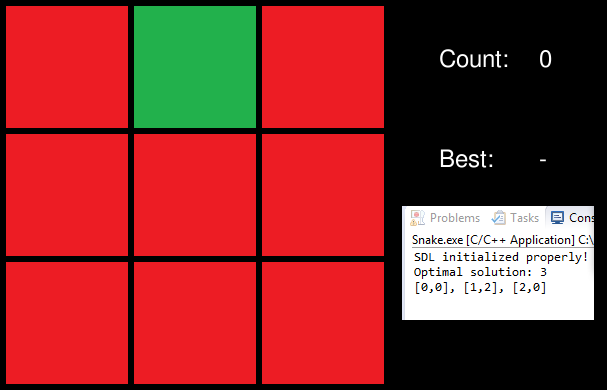Since Snake wasn't really suited to these tasks, I decided to make a new prototype. I remembered an old puzzle from Black & White whereby you had to make a set of randomised trees all the same type. The rule was fairly simple – you had a 3x3 set of trees. If you pulled on a tree, it changed the tree and changed every neighbour of the tree. So there were patterns of 3, 4, or 5 changing depending on the location. Simple enough to code such that the game code itself wouldn't take up much of the development, yet would be useful to get all three aspects missing from the system coded up.
The Camera was a crucial class to get right, and if I was being honest, working out the logic for it has been something that I've been trying to get right in my head for months. Indeed, it was the bane of phase 1 and phase 2. With Level finally sorted out, it was more a matter of getting Camera right. The Level introduced the idea of WorldCoordinate – a simple structure that holds two doubles. So Camera could have a position relative to the Level by holding a world coordinate and the tile dimensions.
Camera needed to do a number of other things. For one, Camera had to be accessible by every AnimationObject so that the destination rect could be relative to the Camera rather than the level. This way textures could be updated out of sight of the game code. The other major thing was to keep track of the mouse, to keep track of where it is on screen and to be able to translate back into a WorldCoordinate for use in-game.
When designing my Input class in the abstract, I thought all I would need to do was keep track of the relative movement of the mouse. This proved to have a limited utility when running in Windowed mode – with the absolute position of the cursor sometimes moving out of the window altogether while not being able to reach certain objects in game. It’s this kind of phenomenon that has helped me understand how important prototypes are to getting the engine running right.
In order to get the prototype up and running, I avoided working out how to display a cursor, and instead used an overlay object for the squares themselves. It worked well enough, and well enough to force me to revisit the equations in the Camera class for getting the translation of WorldCoordinate right. By this stage, I had a working prototype, as seen here.
The last thing I wanted to do was to get text rendering on the screen. For the prototype, I wanted to display something simple – the number of moves in trying to solve the puzzle. With TextureObject (my wrapper of SDL_Texture), the textures were meant to live for the lifetime of the application, so it could be managed by TextureManager. With text, its creation and destruction needed to be with regards to its use. Obviously I don’t want this to be manual, so when I created TextObject (the text equivalent of AnimationObject) I handled the deletion of text objects in code.
It turned out getting text on screen was mostly straightforward. The only problem was the difference between relative and absolute positioning of text. Obviously I would want the option of having both, but I haven’t come up with a good solution yet. For now I’ve created two objects: TextObject and TextGameObject with game objects being camera-relative while TextObject has an absolute position. When I get to working on the HUD, I might encounter this problem with AnimationObject, so there’s a refactor issue.
In the absence of another prototype idea, I refactored the game itself with an algorithm to brute-force a solution. Taking a purely random approach to the game meant that occasionally really easy puzzles would be thrown up (I coded to stop 0-step puzzles). So I wrote an algorithm that would brute-force a solution - to work out just what are the moves needed to solve the puzzle from any given position. This didn't advance the engine in any way, but was a good coding exercise nonetheless.

No comments:
Post a Comment